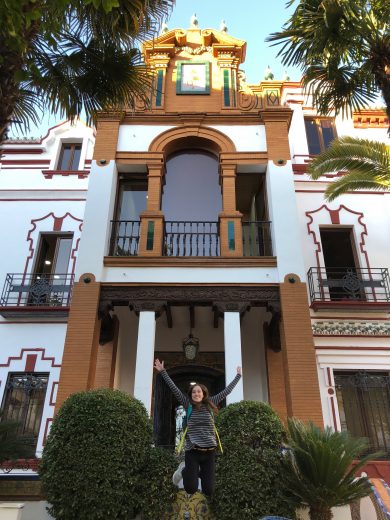Ask me about Bennett’s Model of Intercultural Sensitivity. Seriously. I could talk about it for hours. Any student who has taken LEAD 350, Culture in Context, would say the same. We could quote each one of his six stages, give examples, and even describe how it affects the cultural lens through which we, on an individual basis, view the world. But what if I told you there is a way to shatter that lens… to see everything, untouched, with your own two eyes? What if I told you that the best way to learn about Bennett’s Model is to live it?
This semester, I have had the incredible opportunity to study abroad in Seville, a city located in the southernmost region of Spain. Seville fosters a culture so rich and meaningful that I have already fallen completely in love with it. However, I would be lying if I said that adapting to the culture was always easy. Be it big cultural differences, such as the heavy Catholic influence and the Spanish language, or small ones, such as the lack of free water at restaurants; cultural adjustment takes time. What matters is that you try. At the beginning of my study abroad experience, I decided I wanted to immerse myself completely, so I chose to live with a Spanish host-family. By making this decision, I forced myself to take a leap outside of my comfort zone. The beauty in doing this is that, eventually, your comfort zone stretches to meet you. It is true that sometimes cultural immersion makes you feel like you are drowning, but through time, you find yourself learning new ways to breathe. Consequently, the feeling of empowerment that follows is truly unmatched.
What does this have to do with the Staley School of Leadership Studies? The answer is EVERYTHING. Cultural acceptance does not just happen on its own. Instead, it takes a determined person, an open mind, and some essential leadership strategies. But how can you strive for cultural acceptance without knowing what it is or why it is important? That’s where Bennett’s Model comes in handy. Bennett’s Model of Intercultural Sensitivity was my favorite leadership concept that I learned in LEAD 350. As a refresher, Bennett’s Model consists of six stages describing different views a person can have about cultural differences. The three ethnocentric stages are denial, defense, and minimization; the three ethnorelative stages are acceptance, adaptation, and integration. In class, I always thought you maneuvered these stages like an escalator, only moving up towards the more ethnorelative stages. Now, however, I see that Bennett’s Model is more like a staircase. The goal is to go up, but it’s just as easy to go back down. Only because I identify with the acceptance stage one day, doesn’t mean I can’t revert down to the minimization stage the next day. For example, I’ll have a full day of interacting with my host mom in Spanish and following a meal schedule that I wasn’t previously accustomed to, and I’ll feel as though I have found a permanent spot in the adaptation stage. Then the next day, I’ll find myself getting frustrated on my way to class because I might think that “Spaniards walk too slowly” and I’ll identify more with the minimization stage. I think Bennett would say that this is a natural part of the pursuit of ethnorelativism. It is not meant to be discouraging, and it is not meant to be taken as a “failure.” On the contrary, it is meant to remind you that cultural sensitivity is not something that is simply achieved, but rather something that is worked towards every day.
While abroad, I have frequently utilized the strategies that I learned at the Staley School. The one I have found most applicable to my experience is the Iceberg Analogy. Have you heard of it? The analogy goes as follows: You are sailing across the sea, and you come across an iceberg. There is a small part that you can see with your own eyes, but there is also an unseen component below the surface that is just as present. The top part of the iceberg is some visual aspect, such as a behavior or an event, while the bottom part of the iceberg is the cultural meaning behind it. As leaders, we must learn the significance behind something before making judgements. One of my best practical applications of this strategy occurred at a restaurant during one of my first nights in Spain. I was trying to pay for my meal, but the waiter had not come to my table since delivering my food. At first, I thought the restaurant had bad service. After learning more about the Spanish culture, however, I discovered that waiters in Spain do not want to bother or interrupt you, so they wait until you call for them to bring the check. Thus, what I initially interpreted as lousy service, ended up being a respectable cultural norm.
The most important thing I’ve learned while abroad is that differences don’t have to be scary. Cultural learning isn’t always easy or comfortable, but some of the best leaders are the people who are brave enough to pursue it anyway! After studying abroad, seeing the world, learning about and immersing myself in a different culture, I am positive the Staley School is the best place I could have started my journey. I am a living, breathing example that leadership studies IS extremely valuable. When you find yourself referencing a group discussion you had in class to help you through an uncomfortable cultural confrontation, you know that you chose a minor that is worth your time. I’m so grateful for the privilege to turn my leadership studies minor into a way of life in the greatest classroom of them all: the world.

